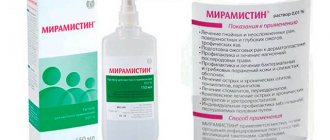The child often swallows saliva before going to bed
Hello!
The child is almost 4 years old, complaints - slight congestion, crusts in the nose, snoring at night, there was (passed) a smell from the nose in the morning. When palpating, the doctor said, “Well, actually, they’re not that big on you, but he still wrote (as it seemed to me, just in case) 2nd degree hr. adenoiditis (?). The smears revealed no pathogenic flora; the rhinocytogram showed 0 eosinophils. During the day, the child does not show any complaints, only sometimes I notice a slight nasal tone. But every night is a test for us. First there was snoring. Next, what, in fact, especially worries me. It started about 3 months ago, I began to notice that the child was waking up to swallow saliva. Further more. There was a slight exacerbation (adenoiditis?), a slightly elevated temperature (37.3), a slight runny nose, and the night swallowing of saliva became simply terrifying. He wakes up every hour and swallows, swallows, swallows. In the dark, the husband actually thought that the child was drinking something in one gulp. At the same time, he sometimes grinds his teeth. The sleep, of course, is very restless; the child does not get enough sleep. What could this endless swallowing of saliva be a symptom of? The ENT specialist sees “nothing like that”! Yes, just in case, tests for worms and lamblia are always clean. I'll add more. Sometimes there are complaints about a stuffy ear in the morning.
The symptoms you described may be a manifestation of enlarged adenoids and adenoiditis. It is not entirely clear what “ENT sees nothing” means if these diagnoses appear in your description. It is not the swallowing of saliva itself that is important, but the way the nose breathes, including at night.
The symptoms you described may be a manifestation of enlarged adenoids and adenoiditis. It is not entirely clear what “ENT sees nothing” means if these diagnoses appear in your description. It is not the swallowing of saliva itself that is important, but the way the nose breathes, including at night.
I got the impression that if we came “without complaints,” then there would be no diagnosis of stage 2 adenoiditis. (when palpated) there would not be. But since the complaints were probably typical for this diagnosis, they wrote to us what they wrote. By the way, they wrote it with some… hesitation.
Now night salivation has appeared. I read and do not see that increased salivation is a symptom of adenoiditis. And in general, I am somewhat surprised that this diagnosis is made almost without exception, while others seem not to. After all, testing by probing is not particularly accurate, is it?
During the day the nose is completely normal. The problems are only at night. A therapist with extensive experience, whom we have been seeing since birth, is generally extremely surprised by this diagnosis, since the child was ill very little, and, as she said, “he could not have time to grow adenoids.” What other ENT diagnoses are possible with such constant swallowing at night?
Adenoiditis and adenoids are not the same thing. With adenoiditis, the inflammatory process is pronounced; with enlarged adenoids, the child may not have any inflammation or complaints at all. And adenoiditis does not imply a pronounced enlargement of the adenoids, at the same time, the adenoids can temporarily enlarge during illness, including simply ARVI. The fact that complaints appear at night with adenoiditis is due to the fact that there is inflammation of the back of the nose, and it is in a horizontal position that this interferes, mucus accumulates in the pharyngeal cavity (it cannot drain easily as during the day) and the child can swallow and cough etc. Regarding teeth grinding, this is possible due to excess tension in the child’s body if the child does not relax completely.
Please tell me how much you worry about your baby’s illnesses? And try to distinguish between complaints - what worries you, and what worries the child?
How to teach a child to chew
The most common reason that a child refuses to chew is the baby’s untimely, too late introduction to solid food. Mothers often get carried away by grinding foods into purees, even for older babies. The result is that the child does not know how to make an effort to eat food, swallows unchewed pieces, and chokes on them. Or he refuses to eat at all, becomes capricious and cries until he receives the usual puree.
Chewing skills need to be instilled from the moment the baby begins to pull all objects into his mouth. Itching in the gums is the first sign of the imminent appearance of teeth. For some it begins at 4-5 months, for others at 7 and later. Now is the time to start introducing your baby to solid food. It is very important to catch the first tooth. When the baby's incisors come out, he will no longer be able to chew with his gums.
What does chewing skill affect (in addition to preparing for the introduction of “adult” food into the children’s menu):
- For the formation of a correct bite and the health of future teeth.
- On the functioning of the digestive system and its development. Solid food, which the child will soon begin to eat constantly, must be treated with saliva. Chewing movements contribute to its formation. They are also necessary for the production of gastric juice and enzymes. If you offer your baby only pureed food, there is a risk that the stomach will become “lazy” and later will not be able to digest food in the form of pieces.
- To strengthen the muscles involved in articulation. Your baby needs to chew to prepare for speech development. If the child does not do this, the muscles lose tone, and subsequently problems may arise with the pronunciation of certain sounds.
If you are worried that your baby may choke, or the baby himself is afraid of solid food in his mouth, use a nibbler (also known as a feeding net, feeder or fruittaker). This is a device with a holder for a child's hand. A piece of food is placed in a special mesh (made of fabric or silicone), the baby can completely safely get acquainted with new foods and improve their chewing skills. Many of our mothers and grandmothers at one time simply wrapped a slice of apple in gauze, the principle was the same. Despite the fact that the possibility of choking on food in this case is minimized, be sure to keep an eye on your baby chewing the nibbler and carefully monitor the cleanliness of the mesh, washing it after each use.
#PROMO_BLOCK#
What to do if the baby has not learned to chew in time and even at 2-3 years old refuses solid food? Be patient and take action. At this time, kids are already very clever at manipulating adults; don’t follow the lead, but gently insist on your own.
- Of course, you cannot starve a child (“if he gets hungry, he will eat”). Introduce solid foods gradually. Add very small pieces of fruits and vegetables to your food, gradually increasing their quantity and size on the plate.
- Lead by example. A small child enjoys repeating after adults or peers. If everyone around him eats delicious pieces, he will also become interested.
- Eat out more often. Explain to your child that there is no usual food here, offer to try something new - children's curiosity in this situation often plays into the parents' hands.
- Involve your baby in cooking. Explain that the blender is broken, offer to mash the vegetables with a fork (it won’t be possible to do this too finely).
- Turn eating into a game. Be creative - play as a bunny nibbling on a carrot, put a bright story on the plate that will attract the child's attention. Fantasize.
Keep in mind that reluctance to chew may be due to the child’s temperament - if the baby is too lazy or, on the contrary, hyperactive and unable to concentrate. In this case, you can consult a psychologist about your actions. Also, if the problem cannot be solved, we advise you to contact a children's speech therapist - special exercises and training of the facial muscles will help not only develop speech skills, but also affect the ability and desire to chew.
What to do with increased salivation in children?
Hypersalivation can occur at absolutely any age. The reasons for this phenomenon may be:
Only a qualified pediatrician can determine the exact cause of increased salivation in a child based on complaints from the mother, father or the child himself and the results of laboratory tests.
Excessive drooling is normal in children, but can also be a symptom of a variety of illnesses. If this symptom is very disturbing, you need to find out the cause of the discharge. The doctor determines the amount of saliva produced within ten minutes. It is also worth visiting doctors of narrow specializations. This is necessary in order to identify the underlying disease that causes severe salivation.
If the cause is not yet completely clear, then if irritation occurs, special ointments or creams should be used to soothe the irritation. It is also necessary to wipe saliva from your chin or lips from time to time. To do this, it will be enough to take a clean handkerchief or dry wipes.
In case of hypersalvation, the doctor prescribes anticholinergic blockers. This drug reduces the influence of the nervous system on the organs responsible for salivation in the child’s body, thereby weakening the secretions.
The child chokes while feeding: what to do?
A newborn chokes when feeding for various reasons. Some of them the mother can eliminate, while others depend on the baby’s health. Pediatrician Anastasia Anatolyevna Nikulina will explain the causes and solutions to this problem.
— Anastasia Anatolyevna, at what age do children most often choke when feeding?
— In the first weeks of life, when the swallowing reflex is still very weak, it is difficult to dose the supply of milk from the breast. From the bottle, the flow of milk formula is controlled using the hole in the nipple and the tilt. If the hole in the nipple does not correspond to its age, it is tight, then the newborn swallows air. Excess air with the mixture will enter the intestines, causing discomfort in the baby.
Why does a baby choke when breastfeeding or bottle feeding?
- Poor baby position or bottle angle. In an optimal position. In the desired position, the hand of the woman holding the child lies on the support. Hold the baby by the back and shoulders, directing the head to the chest. You can’t put too much pressure on the head - the baby will tilt it back reflexively.
- Anatomical features of the mother's breast, in which the woman produces enough breast milk, but it is difficult for the child to suck it and eat it. Before feeding, the mother needs to express some of the milk or massage the breasts: it will become soft and it will be easier for the baby to suck.
- Large nipples are difficult for a child to grasp; to solve the problem, there are special nipple covers through which newborns are fed. You can feed your baby expressed milk through a bottle and an age-appropriate pacifier.
- Hyperlactation. Breast milk flows under pressure into the baby's mouth. Before feeding, part of the foremilk is expressed, and the next, fatter one, does not form a strong flow. Taking breaks during the sucking process also helps.
- Frequent breastfeeding. The absence of long breaks between breastfeeding prevents child hunger and, along with it, rush during feeding.
- Incorrect bottle delivery method. The neck of the bottle must be completely filled with milk: this way there will be no air in the milk. The pacifier is selected taking into account the baby's age.
- Disease. Poor nasal breathing or coughing interferes with feeding. Relieving the symptoms of the disease will improve nutrition. In some children, problems may be caused by poor swallowing or reflux.
- To understand why your baby is having difficulty swallowing, you need to gradually eliminate each of the possible causes. Even the environment matters. During feeding hours, it is advisable for a woman to be alone with her child; nothing should distract him from the process. If a mother finds it difficult to identify the cause, a pediatrician will help her.
— What to do if a child chokes on milk or formula?
— A spontaneously occurring cough is the main symptom that appears when the act of sucking and swallowing is disturbed. The baby cries and refuses to eat.
First aid for choking children
If you can’t cough up excess milk on your own or the baby chokes on saliva and begins to choke, you need to do the following, dosing the strength of your actions:
- Place the baby on one arm, belly down, with your free hand apply pressure on the area above the navel (on the area of the baby's stomach), supporting the chin.
- Lean the child forward a little and lightly pat the back. This will make your cough worse and help restore your breathing.
— Is it possible to continue feeding after the child has coughed, or should I take a break?
- Feeding can be continued after the baby has cleared his throat. It is advisable to carry it in a column for two to three minutes to allow excess air to escape, and then resume feeding.
— Does increasing the intervals between feedings help cope with the problem?
- On the contrary, frequent feeding will be the prevention of choking. With numerous latches, less milk accumulates in a woman’s breasts, making it easier for the mother to feed.
If the child chokes, feeding must be interrupted. The baby will clear his throat, rest and continue to suck. If the situation occurs frequently, be sure to consult your pediatrician. Your doctor will help you find the best breastfeeding or formula-feeding option that suits your situation.
Pediatrician Anastasia Anatolyevna Nikulina
*The ideal food for an infant is mother's milk. WHO recommends exclusive breastfeeding for the first 6 months. MAMAKO® supports this recommendation. Before introducing new foods into your baby’s diet, consult a specialist.
Hormonal changes
Adolescence for boys and girls, contrary to popular belief, begins at age 12. It is at this age that the first menstruation and morning sperm eruption appear. The beginning of changes in the “natural status” is accompanied by a restructuring of many metabolic processes, which leads to sweating, increased salivation, the formation of acne, and so on.
To help a teenager survive this difficult stage, you need to take him to a doctor. A qualified specialist will give useful recommendations on caring for yourself and your body, nutrition program, and prescribe homeopathic teas or tablets. After passing the first stage of external and internal stabilization of the hormonal background, the phenomena of hypersalivation disappear.
Control and prevention measures
Physiological ptyalism in infants under six months of age and drooling due to teething do not require action. Since this is not a disorder or disease, it is safer to simply wait out this period and help the child cope with it.
In some cases, it is necessary to get rid of the root cause if excessive salivation in a child is the result of an allergic reaction or taking medications. In this case, you should stop taking the medication or get rid of the allergen.
Gymnastics and massage of the facial muscles in some cases is a very effective measure. In addition, an older child who can already chew and take solid food on his own can be offered solid foods, for example, apples, carrots, for additional training of the masticatory muscles.
In any case, if you are concerned about your baby's drooling for no reason, it is better to dispel these worries with a visit to the doctor.
The specialist will determine the cause of this phenomenon and, if necessary, prescribe additional studies.
Usually, severe pathologies and diseases that cause hypersalivation and ptyalism are known already at birth or some time after. For example, drooling in cerebral palsy is very common.
If any disease is detected, appropriate treatment is prescribed. Sometimes it is enough to follow a certain diet and periodically rinse the mouth with medicinal solutions, and do not neglect cryotherapy. In some cases, surgical intervention may be required to limit the secretory function of the salivary glands or partially remove them.
Regurgitation and vomiting
Regurgitation is in most cases a physiological phenomenon that does not require special treatment or observation. But it may look like vomiting, being a sign of dangerous diseases, in which case consultation with a doctor is necessary. Regurgitation and vomiting have a similar mechanism of occurrence, namely, the release of gastric contents into the oral cavity.
It is important to distinguish between them, since vomiting in newborns is very dangerous and can lead to aspiration of contents into the respiratory tract and respiratory arrest.
There are differences between regurgitation and vomiting:
- Regurgitation most often occurs after eating. Usually this is a single, non-repeating episode. The child regurgitates the food he has just eaten; there are no foreign impurities in it.
- Vomiting usually occurs repeatedly. It happens not related to food intake.
- Regurgitation does not affect the child’s well-being and mood - he is active, does not show signs of anxiety, smiles, and plays.
- Vomiting is accompanied by a deterioration in general health. The child is lethargic or restless.
- Regurgitation usually occurs suddenly, and vomiting is preceded by a decrease in activity and mood.
- Vomiting is rarely the only symptom; other problems with the functioning of the digestive tract or fever are also observed.
Vomiting in a child is a reason to see a doctor!
Traditional methods
Treatment consists of rinsing the mouth with infusions of various herbs and their decoctions. Tea, nettle decoction, watery pepper infusion are suitable, and you can also use oak bark or sage. The mass of saliva secreted is also reduced by vegetable oil or very weakly concentrated potassium permanganate.
There are two good recipes that reduce salivation in both children and adults. You need to pour 2 tablespoons of viburnum, which was mashed in advance. Pour boiling water over, cover, wait until it cools completely. Then use the infusion after straining to rinse your mouth; you can drink it throughout the day.
Pathological changes with hypersalivation
We can talk about the presence of pathology with increased salivation only if additional painful changes or clear signs of a disorder are observed. These phenomena include:
Before speculating, you need to find out for sure whether the child’s salivary glands really work in an “intensified mode” and produce more secretions than expected. It often happens that there is no violation of the secretory function of the salivary glands at all, and the normally produced saliva flows randomly from the child’s mouth only because the child does not swallow it for some reason.
Usually, in children under six months of age, one should not focus on this phenomenon, since any specialist in the vast majority of cases will say that this is normal. Drooling (ptialism) occurs at the level of unconditioned reflexes and soon disappears;
Symptoms
The most common symptom of excessive saliva production in children is teething. In children aged 4 to 7 months, baby teeth begin to erupt, and therefore the body reacts to the process by increasing the secretion of saliva. This is a fairly harmless cause of hypersalvation. Afterwards the discharge process will return to normal.
Quite often, stomatitis occurs in children with the symptom of hypersalvation. Stomatitis is characterized by a disease of the oral mucosa and is inflammatory in nature. It becomes quite painful for the baby to swallow, and he stops doing it often, as a result of which saliva remains.
Gingitis can also be one of the causes of hypersalvation. The disease is manifested by inflammation of the gums. Increasing saliva secretion is a protective function of the body.
Increased salivation can be a symptom of clay infestation, as well as a symptom of cerebral palsy.
Ear or throat disease may well be symptoms of hypersalvation.
You should definitely remember: if a child is poisoned by iodine, pesticides or even mercury, you need to immediately take the victim to the hospital. In such cases, of course, there is also profuse salivation.
How to help your child
Now let’s take a closer look at how to deal with hypersalivation in a child. By the way, did you know that with normal secretion, a person produces about 2.5 liters of saliva per day? But what should you do if you notice that your child’s salivation has clearly increased?
It is important to understand the specific reason. If the reason is that teeth are being cut, you should calm down and take a wait-and-see attitude.
In this case, no treatment will be needed. You just need to wait until the teeth erupt and saliva flow returns to normal.
But what if it turns out that the cause of hypersalivation was a certain inflammatory disease? Often the cause may be, for example, ulcerative stomatitis. It is caused by various viruses and bacteria. In response to the onset of inflammation, the body turns on the defense mechanism and secretes more saliva. But this does not mean that you need to leave the body alone with the disease.
It is important to support him with competent therapy in a timely manner. All medications must be prescribed exclusively by a doctor
If treatment is neglected, the infection can affect the salivary glands themselves, and this can seriously threaten the health of the baby. Such diseases should be treated by a dentist or pediatrician. As soon as the source of inflammation is eliminated, salivation should return to normal.
Another reason is helminth infection. This is a very typical problem for children, as they are guilty of putting everything into their mouths. This could be dirty hands, toys, garbage, and even shoes. It is not surprising that from time to time their body is attacked by multiplied helminths. If you begin to suspect that this is the reason, you should contact your pediatrician. He will direct you to take the necessary tests and, based on their results, prescribe therapy.
Exercises
There are good exercises that help kids cope with this task.
There is a hole under the jaw; it needs to be developed with vibrating movements with your index finger for about 5 seconds.
Another option: find two points at the base of your tongue under your tongue, massage them counterclockwise for about 10 seconds.
A little below the baby’s ears you can find areas where the jaws touch (close). It is necessary to make small circular movements along the points of contact. First you need to do it with your mouth covered, then tell your child to open his mouth for a while and continue the procedure.
You can place an ice cube on your child's lips. Sometimes you should gargle with slightly warm mineral water. Also let your child chew crackers or carrots to train his facial muscles.










